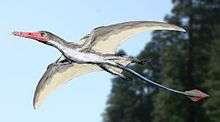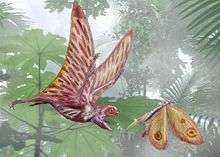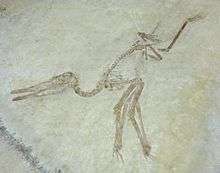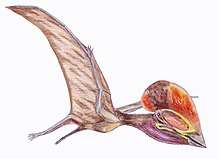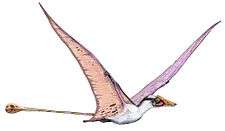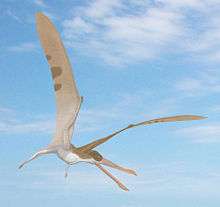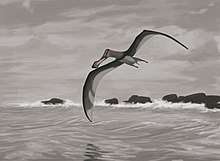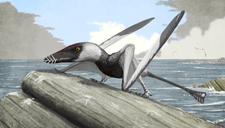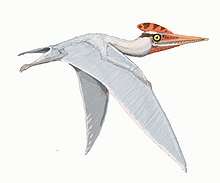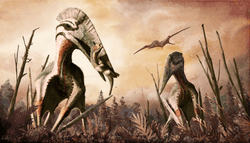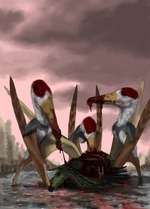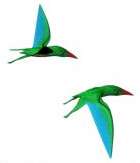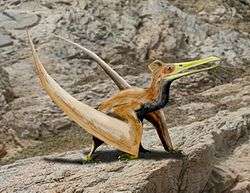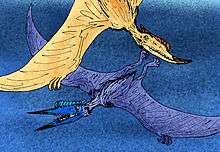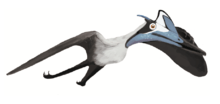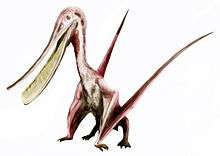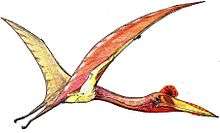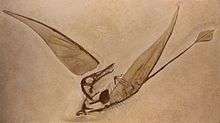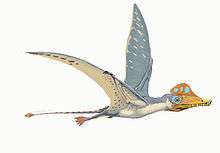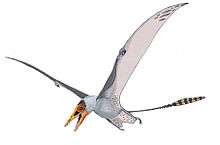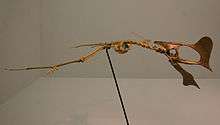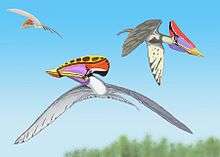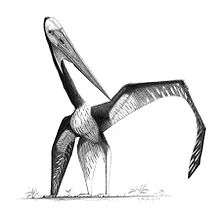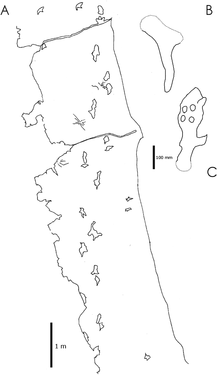List of pterosaur genera
This list of pterosaurs is a comprehensive listing of all genera that have ever been included in the order Pterosauria, excluding purely vernacular terms. The list includes all commonly accepted genera, but also genera that are now considered invalid, doubtful (nomen dubium), or were not formally published (nomen nudum), as well as junior synonyms of more established names, and genera that are no longer considered pterosaurian. The list currently includes 235 genera.
Scope and terminology
There is no official, canonical list of pterosaur genera, but the most thorough attempts can be found at the Pterosauria section of Mikko Haaramo's Phylogeny Archive,[1] the Genus Index at Mike Hanson's The Pterosauria,[2] supplemented by the Pterosaur Species List,[3] and in the fourth supplement of Donald F. Glut's Dinosaurs: The Encyclopedia series.[4]
Authors and year
The authors column lists the authors of the formal description responsible for the erection of the genus listed. They are not necessarily the same as the authors of the type species as sometimes a species from one genus is determined sufficiently distinct to warrant the erection of a new genus to house it. If this is the case, only the latter authors will be listed. The year column notes the year the description was published.
Status
Naming conventions and terminology follow the International Code of Zoological Nomenclature. Technical terms used include:
- Junior synonym: A name which describes the same taxon as a previously published name. If two or more genera are formally designated and the type specimens are later assigned to the same genus, the first to be published (in chronological order) is the senior synonym, and all other instances are junior synonyms. Senior synonyms are generally used, except by special decision of the ICZN, but junior synonyms cannot be used again, even if deprecated. Junior synonymy is often subjective, unless the genera described were both based on the same type specimen.
- Nomen nudum (Latin for "naked name"): A name that has appeared in print but has not yet been formally published by the standards of the ICZN. Nomina nuda (the plural form) are invalid, and are therefore not italicized as a proper generic name would be. If the name is later formally published, that name is no longer a nomen nudum and will be italicized on this list. Often, the formally published name will differ from any nomina nuda that describe the same specimen.
- Preoccupied name: A name that is formally published, but which has already been used for another taxon. This second use is invalid (as are all subsequent uses) and the name must be replaced. As preoccupied names are not valid generic names, they will also go unitalicized on this list.
- Nomen dubium (Latin for "dubious name"): A name describing a fossil with no unique diagnostic features. As this can be an extremely subjective and controversial designation, this term is not used on this list.
Age
The age column denotes the epoch of geologic time to which the fossils date. Genera that are invalid, misidentified, or otherwise do not represent a valid pterosaur are listed as age N/A because there was never a time in which a pterosaur by that generic name actually lived.
Location and notes
The location column designates the geographic region where remains of the relevant genus have been found. The regions used are continents except in the case of smaller landmasses (e.g. Cuba). Political bodies, being non-existent in the Mesozoic are not used to indicate genera locations. Genera that are invalid, misidentified, or otherwise do not represent a valid pterosaur are listed as location N/A because there was never a place in which a pterosaur by that generic name actually lived. The notes column is a collection of annotations on the scientific significance and taxonomic history of listed genera, as well as elaborations on the information presented in other columns.
The list
Genera
|
| ||||||||||||||||||||||||||||||||||||||||||||||||||||||||||||||||||||||||||||||||||||||||||||||||||||||||||||||||||||||||||||||||||||||||||||||||||||||||||||||||||||||||||||||||||||||||||||||||||||||||||||||||||||||||||||||||||||||||||||||||||||||||||||||||||||||||||||||||||||||||||||||||||||||||||||||||||||||||||||||||||||||||||||||||||||||||||||||||||||||||||||||||||||||||||||||||||||||||||||||||||||||||||||||||||||||||||||||||||||||||||||||||||||||||||||||||||||||||||||||||||||||||||||||||||||||||||||||||||||||||||||||||||||||||||||||||||||||||||||||||||||||||||||||||||||||||||||||||||||||||||||||||||||||||||||||||||||||||||||||||||||||||||||||||||||||||||||||||||||||||||||||||||||||||||||||||||||||||||||||||||||||||||||||||||||||||||||||||||||||||||||||||||||||||||||||||||||||||||||||||||||||||||||||||||||||||||||||||||||||||||||||||||||||||||||||||||||||||||||||||||||||||||||||||||||||||||||||||||||||||||||||||||||||||||||||||||||||||||||||||||||||||||||||||||||||||||||||||||||||
Ichnogenera
|
| |||||||||||||||||||||||||||||||||||||||||||||
Oogenera
Although pterosaur eggs are known, some with complete embryos, no oogenera have been erected to house them. The holotype of the oospecies Oolithes sphaericus was briefly considered by Harry Govier Seeley to be pterosaurian in origin, although this attribution was dismissed before the formal erection of that oogenus.
See also
- List of dinosaurs
- List of plesiosaurs
- List of pterosaur classifications
- Pterosaur
- Timeline of pterosaur research
References
- Haaramo, Mikko (15 November 2005). "Pterosauria". Mikko's Phylogeny Archive. Archived from the original on 29 March 2007. Retrieved 29 March 2007.
- Hanson, Mike (12 October 2005). "Genus Index". The Pterosauria. Archosauria.org. Archived from the original on 1 July 2007. Retrieved 29 March 2007.
- Hanson, Mike (30 September 2006). "The Pterosaur Species List" (PDF). The Pterosauria. Archosauria.org. Archived from the original (PDF) on 29 July 2007. Retrieved 27 July 2007.
- Glut, Donald F. (2006). "Appendix One: Pterosaurs". Dinosaurs: The Encyclopedia. 4th Supplement. Jefferson, North Carolina: McFarland & Company, Inc. pp. 583–633. ISBN 978-0-7864-2295-1.
- Vidovic, S. U.; Martill, D. M. (2014). "Pterodactylus scolopaciceps Meyer, 1860 (Pterosauria, Pterodactyloidea) from the Upper Jurassic of Bavaria, Germany: The Problem of Cryptic Pterosaur Taxa in Early Ontogeny". PLoS ONE. 9 (10): e110646. doi:10.1371/journal.pone.0110646. PMC 4206445. PMID 25337830.
- Fernando E. Novas; Martin Kundrat; Federico L. Agnolín; Martín D. Ezcurra; Per Erik Ahlberg; Marcelo P. Isasi; Alberto Arriagada; Pablo Chafrat (2012). "A new large pterosaur from the Late Cretaceous of Patagonia". Journal of Vertebrate Paleontology. 32 (6): 1447–1452. doi:10.1080/02724634.2012.703979.
- Myers, Timothy S. (2010). "A new ornithocheirid pterosaur from the Upper Cretaceous (Cenomanian–Turonian) Eagle Ford Group of Texas". Journal of Vertebrate Paleontology. 30 (1): 280–287. doi:10.1080/02724630903413099.
- Nesov, Lev A. (1981). "[Flying reptiles from the Late Cretaceous of Kyzyl-Kum]". Paleontologicheskii Zhurnal (in Russian). 15: 98–104.
- Andres, =Brian; Myers, Timothy S. (2013). "Lone Star Pterosaurs". Earth and Environmental Science Transactions of the Royal Society of Edinburgh. 103 (3–4): 383–398. doi:10.1017/S1755691013000303.
- Ibrahim, N.; Unwin, D.M.; Martill, D.M.; Baidder, L.; Zouhri, S. (2010). "A New Pterosaur (Pterodactyloidea: Azhdarchidae) from the Upper Cretaceous of Morocco". PLoS ONE. 5 (5): e10875. Bibcode:2010PLoSO...510875I. doi:10.1371/journal.pone.0010875. PMC 2877115. PMID 20520782.
- Alexandru A. Solomon; Vlad A. Codrea; Márton Venczel; Gerald Grellet-Tinner (2019). "A new species of large-sized pterosaur from the Maastrichtian of Transylvania (Romania)". Cretaceous Research. in press: Article 104316. doi:10.1016/j.cretres.2019.104316.
- Nicholas R. Longrich; David M. Martill; Brian Andres (2018). "Late Maastrichtian pterosaurs from North Africa and mass extinction of Pterosauria at the Cretaceous-Paleogene boundary". PLOS Biology. 16 (3): e2001663. doi:10.1371/journal.pbio.2001663. PMC 5849296. PMID 29534059.
- Steven U. Vidovic; David M. Martill (2017). "The taxonomy and phylogeny of Diopecephalus kochi (Wagner, 1837) and Germanodactylus rhamphastinus (Wagner, 1851)" (PDF). In D. W. E. Hone; M. P. Witton; D. M. Martill (eds.). New Perspectives on Pterosaur Palaeobiology (PDF). Geological Society of London, Special Publications. 455. The Geological Society of London. pp. 125–147. Bibcode:2018GSLSP.455..125V. doi:10.1144/SP455.12.
- Unwin, David M. Appendix: List of Valid Pterosaur Species. Pterosaurs From Deep Time. New York: Pi Press, 2006. ISBN 0-13-146308-X
- Campos; Kellner (1985). "Panorama of the Flying Reptiles Study in Brazil and South America (Pterosauria/ Pterodactyloidea/ Anhangueridae)". Anais da Academia Brasileira de Ciências. 57 (4): 141–142 & 453–466.
- Döderlein, L. (1923). "Anurognathus ammoni ein neuer Flugsaurier." Sitzungsberichte der Mathematisch-Naturwissenschaftlichen Abteilung der Bayerischen Akademie der Wissenschaften zu München, 1923, 117-164.
- "Anurognathus." In: Cranfield, Ingrid (ed.). The Illustrated Directory of Dinosaurs and Other Prehistoric Creatures. London: Salamander Books, Ltd. Pp. 306-307.
- Williston, Samuel W. (1903). "On the osteology of Nyctosaurus (Nyctodactylus), with notes on American pterosaurs". Fieldiana Geology. 2 (3): 125–163.
- Nesov, L.A., Kanznyshkina, L.F., and Cherepanov, G.O. (1987). "Dinosaurs, crocodiles and other archosaurs from the Late mesozoic of central Asia and their place in ecosystems." Abstracts of the 33rd session of the All-Union Palaeontological Society, Leningrad, pp. 46-47. [In Russian].
- Averianov, A.O. (2007). "New records of azhdarchids (Pterosauria, Azhdarchidae) from the late Cretaceous of Russia, Kazakhstan, and Central Asia". Paleontological Journal. 41 (2): 189–197. doi:10.1134/S0031030107020098.
- Bennett, S. Christopher (2013). "New information on body size and cranial display structures of Pterodactylus antiquus, with a revision of the genus". Paläontologische Zeitschrift. 87 (2): 269–289. doi:10.1007/s12542-012-0159-8.
- Eberhard Frey, Christian A. Meyer and Helmut Tischlinger (2011). "The oldest azhdarchoid pterosaur from the Late Jurassic Solnhofen Limestone (Early Tithonian) of Southern Germany". Swiss Journal of Geosciences. 104: 35–55. doi:10.1007/s00015-011-0073-1.
- Kellner, Alexander W.A.; Taissa Rodrigues; Fabiana R. Costa (2011). "Short note on a pteranodontoid pterosaur (Pterodactyloidea) from western Queensland, Australia" (PDF). Anais da Academia Brasileira de Ciências. 83 (1): 301–308. doi:10.1590/S0001-37652011000100018. PMID 21437387.
- Peters, David (2004). "Did pterosaurs lay eggs?". Prehistoric Times. 67: 21. Archived from the original on 2005-02-11.
- Nesov (1984). "Upper Cretaceous pterosaurs and birds from Central Asia.]". Paleontologicheskii Zhurnal. 1984 (1): 47–57. Archived from the original on 2009-01-05.
- Ösi, Attila; Weishampel, David B.; Jianu, Coralia M. (2005). "First evidence of azhdarchid pterosaurs from the Late Cretaceous of Hungary" (PDF). Acta Palaeontologica Polonica. 50 (4): 777–787. Retrieved 2016-11-30.
- Jaime A. Headden & Hebert B.N. Campos (2015). "An unusual edentulous pterosaur from the Early Cretaceous Romualdo Formation of Brazil". Historical Biology: An International Journal of Paleobiology. 27 (7): 815–826 1–12. doi:10.1080/08912963.2014.904302.
- Elgin, Ross A.; Frey, Eberhard (2011). "A new ornithocheirid, Barbosania gracilirostris gen. et sp. nov. (Pterosauria, Pterodactyloidea) from the Santana Formation (Cretaceous) of NE Brazil". Swiss Journal of Palaeontology. 130 (2): 259–275. doi:10.1007/s13358-011-0017-4.
- Rjabinin, A. N. (1948). "Remarks on a flying reptile from the Jurassic of the Kara-Tau". Akademia Nauk. 15 (1): 86–93.
- "Batrachognathus." In: Cranfield, Ingrid (ed.). The Illustrated Directory of Dinosaurs and Other Prehistoric Creatures. London: Salamander Books, Ltd. Pp. 320-321.
- Lü, J.-C. (2003). "A new pterosaur: Beipiaopterus chenianus, gen. et sp. nov. (Reptilia: Pterosauria) from Western Liaoning Province, China". Memoir of the Fukui Prefectural Dinosaur Museum. 2: 153–160.
- David W. E. Hone; Helmut Tischlinger; Eberhard Frey; Martin Röper (2012). "A New Non-Pterodactyloid Pterosaur from the Late Jurassic of Southern Germany". PLoS ONE. 7 (7): e39312. Bibcode:2012PLoSO...739312H. doi:10.1371/journal.pone.0039312. PMC 3390345. PMID 22792168.
- Vecchia, Fabio M. Dalla (July 2018). "COMMENTS ON TRIASSIC PTEROSAURS WITH A COMMENTARY ON THE "ONTOGENETIC STAGES" OF KELLNER (2015) AND THE VALIDITY OF BERGAMODACTYLUS WILDI". Rivista Italiana di Paleontologia e Stratigrafia (Research in Paleontology and Stratigraphy). 124 (2): 317–341. doi:10.13130/2039-4942/10099. ISSN 2039-4942.
- Nesov; Yarkov, A.A. (1989). "New Birds from the Cretaceous–Paleogene of the USSR and Some Remarks on the History of Origin and Evolution of the Class". Tr. Zool. Inst. Akad. Nauk SSSR. 197: 78–97.
- Lü, Junchang; Ji, Qiang (2005). "A new ornithocheirid from the Early Cretaceous of Liaoning Province, China". Acta Geologica Sinica. 79 (2): 157–163. doi:10.1111/j.1755-6724.2005.tb00877.x.
- Kellner, A. W. A. (1984). "Ocorrencia de uma mandibula de pterosauria (Brasileodactylus araripensis, nov. gen.; nov. sp.) na Formacao Santana, Cretaceo da Chapada do Araripe, Ceara-Brasil." Anais XXXIII Cong. Brasil. de Geol, 578–590. Rio de Janeiro.
- Gasparini, Zulma; Fernández, Marta; de la Fuente, Marcelo (2004). "A new pterosaur from the Jurassic of Cuba". Palaeontology. 47 (4): 919–927. doi:10.1111/j.0031-0239.2004.00399.x.
- Brooks B. Britt; Fabio M. Dalla Vecchia; Daniel J. Chure; George F. Engelmann; Michael F. Whiting; Rodney D. Scheetz (2018). "Caelestiventus hanseni gen. et sp. nov. extends the desert-dwelling pterosaur record back 65 million years". Nature Ecology & Evolution. 2 (9): 1386–1392. doi:10.1038/s41559-018-0627-y. PMID 30104753.
- Paulo C. Manzig; Alexander W. A. Kellner; Luiz C. Weinschütz; Carlos E. Fragoso; Cristina S. Vega; Gilson B. Guimarães; Luiz C. Godoy; Antonio Liccardo; João H. Z. Ricetti; Camila C. de Moura (2014). "Discovery of a Rare Pterosaur Bone Bed in a Cretaceous Desert with Insights on Ontogeny and Behavior of Flying Reptiles". PLoS ONE. 9 (8): e100005. Bibcode:2014PLoSO...9j0005M. doi:10.1371/journal.pone.0100005. PMC 4131874. PMID 25118592.
- Rodrigues, Taissa; Kellner, Alexander Wilhelm Armin (2013). "Taxonomic review of the Ornithocheirus complex (Pterosauria) from the Cretaceous of England". ZooKeys (308): 1–112. doi:10.3897/zookeys.308.5559. PMC 3689139. PMID 23794925.
- Plieninger, F. 1895 "Campylognathus Zitteli, ein neuer Flugsaurier aus dem obersten Lias Schwabens", Paläontographica 41, 193–222 & pl. 19.
- "Campylognathoides." In: Cranfield, Ingrid (ed.). The Illustrated Directory of Dinosaurs and Other Prehistoric Creatures. London: Salamander Books, Ltd. Pp. 296-297.
- Dalla Vecchia, Fabio M. (2009). "Anatomy and systematics of the pterosaur Carniadactylus (gen. n.) rosenfeldi (Dalla Vecchia, 1995)". Rivista Italiana de Paleontologia e Stratigrafia. 115 (2): 159–188.
- Xiaolin, Wang; Zhonghe, Zhou (2006). "Pterosaur assemblages of the Jehol Biota and their implication for the Early Cretaceous pterosaur radiation". Geological Journal. 41 (3–4): 405–418. doi:10.1002/gj.1046.
- Xiaolin, Wang; Zhou, Zhonghe (2006). Rong, Jiayu; Fang, Zongjie; Zhou, Zhonghe; Zhan, Renbin; Yuan, Xunalai (eds.). "Originations and Radiations—Evidences from the Chinese Fossil Record". Beijing: Science Press: 665–689, 937–938. Cite journal requires
|journal=(help) - Steel, L.; Martill; Unwin; Winch, J. D. (2005). "A new pterodactyloid pterosaur from the Wessex Formation (Lower Cretaceous) of the Isle of Wight, England". Cretaceous Research. 26 (4): 686–698. doi:10.1016/j.cretres.2005.03.005.
- Alexander W. A. Kellner (2013). "A new unusual tapejarid (Pterosauria, Pterodactyloidea) from the Early Cretaceous Romualdo Formation, Araripe Basin, Brazil". Earth and Environmental Science Transactions of the Royal Society of Edinburgh. 103 (3–4): 409–421. doi:10.1017/S1755691013000327.CS1 maint: uses authors parameter (link)
- Fröbisch, N.B.; Fröbisch, J. (2006). "A new basal pterosaur genus from the Upper Triassic of the Northern Calcareous Alps of Switzerland". Palaeontology. 49 (5): 1081–1090. doi:10.1111/j.1475-4983.2006.00581.x.
- Leonardi, G.; Borgomanero, G. (1985). "Cearadactylus atrox nov. gen., nov. sp.: novo Pterosauria (Pterodactyloidea) da Chapada do Araripe, Ceara, Brasil". Resumos dos communicaçoes VIII Congresso bras. de Paleontologia e Stratigrafia. 27: 75–80.
- Lü, J. (2009). "A new non-pterodactyloid pterosaur from Qinglong County, Hebei Province of China". Acta Geologica Sinica. 83 (2): 189–199. doi:10.1111/j.1755-6724.2009.00062.x.
- Xiao-Lin, Wang; Zhong-He, Zhou (2003). "Two new pterodactyloid pterosaurs from the Early Cretaceous Jiufotang Formation of Western Liaoning, China". Vertebrata PalAsiatica. 41 (1): 34–41.
- Galton, P.M. (1981). "A rhamphorhynchoid pterosaur from the Upper Jurassic of North America". Journal of Paleontology. 55: 1117–1122.
- David W. E. Hone; Michael B. Habib; François Therrien (2019). "Cryodrakon boreas gen. et sp. nov. a Late Cretaceous Canadian azhdarchid pterosaur". Journal of Vertebrate Paleontology. 39 (3): e1649681. doi:10.1080/02724634.2019.1649681.
- von Meyer, C. E. H. 1852, Ctenochasma Roemeri. Paläontographica 2, 82–84 & pl. 13.
- "Ctenochasma." In: Cranfield, Ingrid (ed.). The Illustrated Directory of Dinosaurs and Other Prehistoric Creatures. London: Salamander Books, Ltd. Pp. 316-317.
- Martill, David M.; Etches, Steve (2013). "A new monofenestratan pterosaur from the Kimmeridge Clay Formation (Upper Jurassic, Kimmeridgian) of Dorset, England" (PDF). Acta Palaeontologica Polonica. 58 (2): 285–294. doi:10.4202/app.2011.0071.
- "Gallodactylus." In: Cranfield, Ingrid (ed.). The Illustrated Directory of Dinosaurs and Other Prehistoric Creatures. London: Salamander Books, Ltd. Pp. 312-313.
- Maisch, M.W.; Matzke, A.T.; Ge Sun (2004). "A new dsungaripteroid pterosaur from the Lower Cretaceous of the southern Junggar Basin, north-west China". Cretaceous Research. 25 (5): 625–634. doi:10.1016/j.cretres.2004.06.002.
- Lü, J.; Unwin, D. M.; Jin, X.; Liu, Y.; Ji, Q. (2009). "Evidence for modular evolution in a long-tailed pterosaur with a pterodactyloid skull". Proceedings of the Royal Society B. 277: 383–9. doi:10.1098/rspb.2009.1603. PMC 2842655. PMID 19828548.
- Kellner, A.W.A. (2010). "Comments on the Pteranodontidae (Pterosauria, Pterodactyloidea) with the description of two new species". Anais da Academia Brasileira de Ciências. 82 (4): 1063–1084. doi:10.1590/s0001-37652010000400025. PMID 21152777.
- Ji, S.-A.; Ji, Q.; Padian (1999). "Biostratigraphy of new pterosaurs from China". Nature. 398 (6728): 573–574. Bibcode:1999Natur.398..573J. doi:10.1038/19221.
- Ji, S.-A.; Ji, Q. (1998). "A new fossil pterosaur (Rhamphorhynchoidea) from Liaoning". Jiangsu Geology. 22 (4): 199–206.
- "Dimorphodon." In: Cranfield, Ingrid (ed.). The Illustrated Directory of Dinosaurs and Other Prehistoric Creatures. London: Salamander Books, Ltd. Pp. 288-291.
- Martill; Frey, E.; Diaz, G.C.; Bell, C.M. (2000). "Reinterpretation of a Chilean pterosaur and the occurrence of Dsungeripteridae in South America". Geological Magazine. 137 (1): 19–25. Bibcode:2000GeoM..137...19M. doi:10.1017/s0016756800003502.
- Seeley, H. G. (1875). "On an Ornithosaurian (Doratorhynchus validus) from the Purbeck Limestone of Langton near Swanage". Quarterly Journal of the Geological Society. 31 (1–4): 465–468. doi:10.1144/GSL.JGS.1875.031.01-04.35.
- "Dorygnathus." In: Cranfield, Ingrid (ed.). The Illustrated Directory of Dinosaurs and Other Prehistoric Creatures. London: Salamander Books, Ltd. Pp. 292-295.
- Xiaoli Wang, Shunxing Jiang, Junqiang Zhang, Xin Cheng, Xuefeng Yu, Yameng Li, Guangjin Wei & Xiaolin Wang, 2017, "New evidence from China for the nature of the pterosaur evolutionary transition", Scientific Reports 7, Article number: 42763
- "Dsungaripterus." In: Cranfield, Ingrid (ed.). The Illustrated Directory of Dinosaurs and Other Prehistoric Creatures. London: Salamander Books, Ltd. Pp. 334-335.
- Andres, B.; Ji, Q. (2008). "A new pterosaur from the Liaoning Province of China, the phylogeny of the Pterodactyloidea, and convergence in their cervical vertebrae". Palaeontology. 51 (2): 453–469. doi:10.1111/j.1475-4983.2008.00761.x.
- Lü, Junchang; Qiang Ji (2005). "New azhdarchid pterosaur from the Early Cretaceous of western Liaoning". Acta Geologica Sinica. 79 (3): 301–307. doi:10.1111/j.1755-6724.2005.tb00893.x.
- Lü, J.C.; B.K. Zhang (2005). "New pterodactyloid pterosaur from the Yixian Formation of western Liaoning". Geological Review. 51 (4): 458–462.
- "Eudimorphodon." In: Cranfield, Ingrid (ed.). The Illustrated Directory of Dinosaurs and Other Prehistoric Creatures. London: Salamander Books, Ltd. Pp. 280-281.
- Romain Vullo; Jesús Marugán-Lobón; Alexander W. A. Kellner; Angela D. Buscalioni; Bernard Gomez; Montserrat de la Fuente; José J. Moratalla (2012). "A New Crested Pterosaur from the Early Cretaceous of Spain: The First European Tapejarid (Pterodactyloidea: Azhdarchoidea)". PLoS ONE. 7 (7): e38900. Bibcode:2012PLoSO...738900V. doi:10.1371/journal.pone.0038900. PMC 3389002. PMID 22802931.
- Mátyás Vremir, Alexander W. A. Kellner, Darren Naish, Gareth J. Dyke (2013). "A New Azhdarchid Pterosaur from the Late Cretaceous of the Transylvanian Basin, Romania: Implications for Azhdarchid Diversity and Distribution". PLoS ONE. 8 (1): e54268. Bibcode:2013PLoSO...854268V. doi:10.1371/journal.pone.0054268. PMC 3559652. PMID 23382886.CS1 maint: uses authors parameter (link)
- Kessler, E.; Jurcsák, T. (1986). "New contributions to the knowledge of the Lower Cretaceous bird remains from Cornet (Romania)". Travaux du Musée d'Histoire Naturelle Grigore Antipa. 28: 289–295.
- Federico L. Agnolin & David Varricchio (2012). "Systematic reinterpretation of Piksi barbarulna Varricchio, 2002 from the Two Medicine Formation (Upper Cretaceous) of Western USA (Montana) as a pterosaur rather than a bird". Geodiversitas. 34 (4): 883–894. doi:10.5252/g2012n4a10. Archived from the original on 2013-01-07.
- Bonaparte, J., Schultz, C., and Soares, M. (2010). "Pterosauria from the Late Triassic of Southern Brazil." In : Bandyopadhyay, S. (ed). New Aspects of Mesozoic Biodiversity. Berlin/Heidelberg: Springer Pp. 63–71.
- Wang, Xiaolin; Campos, Diogenes (October 2005). "Pterosaur diversity and faunal turnover in Cretaceous terrestrial ecosystems in China". Nature. 437 (7060): 875–879. Bibcode:2005Natur.437..875W. doi:10.1038/nature03982. PMID 16208369.
- Lü, J.; Fucha, X.; Chen, J. (2010). "A new scaphognathine pterosaur from the Middle Jurassic of western Liaoning, China". Acta Geoscientica Sinica. 31 (2): 263–266.
- Adele H. Pentland; Stephen F. Poropat; Travis R. Tischler; Trish Sloan; Robert A. Elliott; Harry A. Elliott; Judy A. Elliott; David A. Elliott (2019). "Ferrodraco lentoni gen. et sp. nov., a new ornithocheirid pterosaur from the Winton Formation (Cenomanian–lower Turonian) of Queensland, Australia". Scientific Reports. 9 (1): Article number 13454. doi:10.1038/s41598-019-49789-4. PMC 6776501. PMID 31582757.
- Wang, X.; Kellner; Zhou, Z.; Campos (2007). "A new pterosaur (Ctenochasmatidae, Archaeopterodactyloidea) from the Lower Cretaceous Yixian Formation of China". Cretaceous Research. 28 (2): 2245–260. doi:10.1016/j.cretres.2006.08.004.
- "Germanodactylus." In: Cranfield, Ingrid (ed.). The Illustrated Directory of Dinosaurs and Other Prehistoric Creatures. London: Salamander Books, Ltd. Pp. 310-311.
- Lü Junchang; Ji Qiang; Wei Xuefang; Liu Yongqing (2011). "A new ctenochasmatoid pterosaur from the Early Cretaceous Yixian Formation of western Liaoning, China". Cretaceous Research. 34: 26–30. doi:10.1016/j.cretres.2011.09.010.
- "Gnathosaurus." In: Cranfield, Ingrid (ed.). The Illustrated Directory of Dinosaurs and Other Prehistoric Creatures. London: Salamander Books, Ltd. Pp. 314-315.
- Xiaolin Wang; Alexander W. A. Kellner; Shunxing Jiang; Xin Cheng (2012). "New toothed flying reptile from Asia: close similarities between early Cretaceous pterosaur faunas from China and Brazil". Naturwissenschaften. 99 (4): 249–257. Bibcode:2012NW.....99..249W. doi:10.1007/s00114-012-0889-1. PMID 22354475.
- Victoria M. Arbour; Philip J. Currie (2011). "An istiodactylid pterosaur from the Upper Cretaceous Nanaimo Group, Hornby Island, British Columbia, Canada". Canadian Journal of Earth Sciences. 48 (1): 63–69. Bibcode:2011CaJES..48...63S. doi:10.1139/E10-083.
- Romain Vullo, Eric Buffetaut & Michael J. Everhart (2012). "Reappraisal of Gwawinapterus beardi from the Late Cretaceous of Canada: a saurodontid fish, not a pterosaur". Journal of Vertebrate Paleontology. 32 (5): 1198–1201. doi:10.1080/02724634.2012.681078.
- Xiaolin Wang; Alexander W.A. Kellner; Shunxing Jiang; Qiang Wang; Yingxia Ma; Yahefujiang Paidoula; Xin Cheng; Taissa Rodrigues; Xi Meng; Jialiang Zhang; Ning Li; Zhonghe Zhou (2014). "Sexually Dimorphic Tridimensionally Preserved Pterosaurs and Their Eggs from China". Current Biology. 24 (12): 1323–1330. doi:10.1016/j.cub.2014.04.054. PMID 24909325.
- Wang, X.; Lü, J. (2001). "Discovery of a pterodactloid pterosaur from the Yixian Formation of western Liaoning, China". Chinese Science Bulletin. 45 (12): 447–454.
- Carpenter, K., Unwin, D.M., Cloward, K., Miles, C.A., and Miles, C. (2003). A new scaphognathine pterosaur from the Upper Jurassic Formation of Wyoming, USA. In: Buffetaut, E., and Mazin, J.- M. (eds.). Evolution and Palaeobiology of Pterosaurs. Geological Society of London, Special Publications 217:45-54.
- Buffetaut, E.; Grigorescu, D.; Csiki, Z. (2002). "A new giant pterosaur with a robust skull from the latest Cretaceous of Romania". Naturwissenschaften. 89 (4): 180–184. Bibcode:2002NW.....89..180B. doi:10.1007/s00114-002-0307-1. PMID 12061403.
- Xiaolin Wang; Diogenes de Almeida Kellner (2008). "A primitive istiodactylid pterosaur (Pterodactyloidea) from the Jiufotang Formation (Early Cretaceous), northeast China". Zootaxa. 1813: 1–18. doi:10.11646/zootaxa.1813.1.1.
- Dong, Z.-M. (1982). "On a new Pterosauria (Huanhepterus quingyangensis gen.et. sp.nov.) from Ordos, China". Vertebrata PalAsiatica. 20 (2): 115–121.
- Lü, J.; Yuan, C. (2005). "New tapejarid pterosaur from Western Liaoning, China". Acta Geologica Sinica. 79 (4): 453–458. doi:10.1111/j.1755-6724.2005.tb00911.x.
- Borja Holgado; Rodrigo V. Pêgas; José Ignacio Canudo; Josep Fortuny; Taissa Rodrigues; Julio Company; Alexander W. A. Kellner (2019). "On a new crested pterodactyloid from the Early Cretaceous of the Iberian Peninsula and the radiation of the clade Anhangueria". Scientific Reports. 9 (1): Article number 4940. Bibcode:2019NatSR...9.4940H. doi:10.1038/s41598-019-41280-4. PMC 6426928. PMID 30894614.
- Xiaolin Wang; Taissa Rodrigues; Shunxing Jiang; Xin Cheng; Alexander W. A. Kellner (2014). "An Early Cretaceous pterosaur with an unusual mandibular crest from China and a potential novel feeding strategy". Scientific Reports. 4: Article number 6329. Bibcode:2014NatSR...4E6329W. doi:10.1038/srep06329. PMC 5385874. PMID 25210867.
- Unwin, D. M. and Martill, D. M. (2007). "Pterosaurs of the Crato Formation." In Martill, D. M., Bechly, G. and Loveridge, R. F. (eds), The Crato Fossil Beds of Brazil: Window into an Ancient World. Cambridge University Press (Cambridge), pp. 475-524.
- Wang, X.; Zhou, Z.; Zhang, F.; Xu, X. (2002). "A nearly completely articulated rhamphorhynchoid pterosaur with exceptionally well-preserved wing membranes and 'hairs' from Inner Mongolia, northeast China". Chinese Science Bulletin. 47 (3): 226–232. Bibcode:2002ChSBu..47..226W. doi:10.1360/02tb9054.
- Xin Cheng; Xiaolin Wang; Shunxing Jiang; Alexander W.A. Kellner (2012). "A new scaphognathid pterosaur from western Liaoning, China". Historical Biology. 24: 101–111. doi:10.1080/08912963.2011.635423.
- Lü Junchang & Bo Xue (2011). "A New Rhamphorhynchid Pterosaur (Pterosauria) from the Middle Jurassic Tiaojishan Formation of Western Liaoning, China". Acta Geologica Sinica. 85 (5): 977–983. doi:10.1111/j.1755-6724.2011.00531.x.
- Dong, Z.; Sun, Y.; Wu, S. (2003). "On a new pterosaur from the Lower Cretaceous of Chaoyang Basin, Western Liaoning, China". Global Geology. 22 (1): 1–7.
- Harris, J.D., and Carpenter, K. (1996). A large pterodactyloid from the Morrison Formation (Late Jurassic) of Garden Park, Colorado. Neues Jahrbuch für Geologie und Paläontologie Monatshefte 1996(8):473-484.
- Alexander W.A. Kellner; Luiz C. Weinschütz; Borja Holgado; Renan A. M. Bantim; Juliana M. Sayão (2019). "A new toothless pterosaur (Pterodactyloidea) from Southern Brazil with insights into the paleoecology of a Cretaceous desert". Anais da Academia Brasileira de Ciências. 91 (Suppl. 2): e20190768. doi:10.1590/0001-3765201920190768. PMID 31432888.
- Michael O’Sullivan; David M. Martill (2018). "Pterosauria of the Great Oolite Group (Bathonian, Middle Jurassic) of Oxfordshire and Gloucestershire, England". Acta Palaeontologica Polonica. Online edition. doi:10.4202/app.00490.2018.
- Wang, X.; Kellner, A.W.A.; Jiang, S.; Cheng, X.; Meng, X.; Rodrigues, T. (2010). "New long-tailed pterosaurs (Wukongopteridae) from western Liaoning, China". Anais da Academia Brasileira de Ciências. 82 (4): 1045–1062. doi:10.1590/S0001-37652010000400024. PMID 21152776.
- Brian Andres, James Clark & Xing Xu (2014). "The Earliest Pterodactyloid and the Origin of the Group". Current Biology. 24 (9): 1011–1016. doi:10.1016/j.cub.2014.03.030. PMID 24768054.
- Witton, Mark P. (2008). "A new azhdarchoid pterosaur from the Crato Formation (Lower Cretaceous, Aptian?) of Brazil". Palaeontology. 51 (6): 1289–1300. doi:10.1111/j.1475-4983.2008.00811.x.
- Chang-Fu Zhou; Ke-Qin Gao; Hongyu Yi; Jinzhuang Xue; Quanguo Li; Richard C. Fox (2017). "Earliest filter-feeding pterosaur from the Jurassic of China and ecological evolution of Pterodactyloidea". Royal Society Open Science. 4 (2): 160672. Bibcode:2017RSOS....460672Z. doi:10.1098/rsos.160672. PMC 5367317. PMID 28386425.
- Wang, X.-L.; Zhou, Z.-H. (2003). "Two new pterodactyloid pterosaurs from the Early Cretaceous Jiufotang Formation of Western Liaoning, China". Vertebrata PalAsiatica. 41 (1): 34–41.
- Dong, Z.; Lü, J. (2005). "A New Ctenochasmatid Pterosaur from the Early Cretaceous of Liaoning Province". Acta Geologica Sinica. 79 (2): 164–167. doi:10.1111/j.1755-6724.2005.tb00878.x.
- Kessler, E.; Jurcsák, T. (1984). "Fossil bird remains in the bauxite from Cornet (Romania, Bihor County)". Travaux du Musée d'Histoire Naturelle Grigore Antipa. 25: 393–401.
- Rodrigues, Taissa; Jiang, Shunxing; Cheng, Xin; Wang, Xiaolin; Kellner, Alexander W.A. (2015). "A new toothed pteranodontoid (Pterosauria, Pterodactyloidea) from the Jiufotang Formation (Lower Cretaceous, Aptian) of China and comments on Liaoningopterus gui Wang and Zhou, 2003". Historical Biology. 27 (6): 782–795. doi:10.1080/08912963.2015.1033417.
- Gervais, F. L. P. 1844. Remarques sur les oiseaux fossiles. Thèse, Fac. Sci., Univ. Paris. [Abstract in Bulletin of the Société Philomathique de Paris, pp. 67-70 & L'Institut 12:293-294.]
- Buffetaut, E.; Lepage, J.-J.; Lepage, G. (1998). "A new pterodactyloid pterosaur from the Kimmeridgian of the Cap de la Hève (Normandy, France)". Geological Magazine. 135 (5): 719–722. Bibcode:1998GeoM..135..719B. doi:10.1017/s0016756898001575.
- Wang, L.; Li, L.; Duan, Y.; Cheng, S.L. (2006). "A new istiodactylid pterosaur from western Liaoning, China". Geological Bulletin of China. 25 (6): 737–740.
- Frey, E., Martill, D., and Buchy, M. (2003). A new crested ornithocheirid from the Lower Cretaceous of northeastern Brazil and the unusual death of an unusual pterosaur. In: Buffetaut, E., and Mazin, J.-M. (eds.). Evolution and Palaeobiology of Pterosaurs. Geological Society Special Publication 217:56-63. ISBN 1-86239-143-2.
- Bantim, Renan A. M.; Saraiva, Antônio A. F.; Oliveira, Gustavo R.; Sayão, Juliana M. (2014). "A new toothed pterosaur (Pterodactyloidea: Anhangueridae) from the Early Cretaceous Romualdo Formation, NE Brazil". Zootaxa. 3869 (3): 201–223. doi:10.11646/zootaxa.3869.3.1. PMID 25283914.
- Jensen, J. A.; Padian (1989). "Small pterosaurs and dinosaurs from the Uncompahgre fauna (Brushy Basin Member, Morrison Formation: ?Tithonian), late Jurassic, western Colorado". Journal of Paleontology. 63 (3): 363–374. doi:10.1017/S0022336000019533.
- Ross A. Elgin & Eberhard Frey (2011). "A new azhdarchoid pterosaur from the Cenomanian (Late Cretaceous) of Lebanon". Swiss Journal of Geosciences. 104: 21–33. doi:10.1007/s00015-011-0081-1.
- Alexander W. A. Kellner; Michael W. Caldwell; Borja Holgado; Fabio M. Dalla Vecchia; Roy Nohra; Juliana M. Sayão & Philip J. Currie (2019). "First complete pterosaur from the Afro-Arabian continent: insight into pterodactyloid diversity". Scientific Reports 9. doi:10.1038/s41598-019-54042-z.
- Romain Vullo; Géraldine Garcia; Pascal Godefroit; Aude Cincotta; Xavier Valentin (2018). "Mistralazhdarcho maggii, gen. et sp. nov., a new azhdarchid pterosaur from the Upper Cretaceous of southeastern France". Journal of Vertebrate Paleontology. Online edition (4): (1)-(16). doi:10.1080/02724634.2018.1502670.
- Lü Junchang, Pu Hanyong, Xu Li, Wu Yanhua and Wei Xuefang (2012). "Largest toothed pterosaur skull from the Early Cretaceous Yixian Formation of Western Liaoning, China, with comments on the family Boreopteridae". Acta Geologica Sinica. 86 (2): 287–293. doi:10.1111/j.1755-6724.2012.00658.x.CS1 maint: uses authors parameter (link)
- Padian; Horner, J.R.; de Ricqlès, A.J. (1993). "A new azhdarchid pterosaur from the Two Medicine Formation (Late Cretaceous, Campanian) of Montana, identified on the basis of bone histology". Journal of Vertebrate Paleontology. 13: 52A. doi:10.1080/02724634.1993.10011533.
- Frey, E.; Buchy, M.-C.; Stinnesbeck, W.; González, A.G.; Stefano, A. (2006). "Muzquizopteryx coahuilensis n.g., n. sp., a nyctosaurid pterosaur with soft tissue preservation from the Coniacian (Late Cretaceous) of northeast Mexico (Coahuila)". Oryctos. 6: 19–39.
- Molnar, Ralph E.; Thulborn, R.A. (2008). "An incomplete pterosaur skull from the Cretaceous of north-central Queensland, Australia". Arquivos do Museu Nacional, Rio de Janeiro. 65 (4): 461–470.
- Wang, X.; Kellner; Zhou, Z.; Campos, D.A. (2008). "Discovery of a rare arboreal forest-dwelling flying reptile (Pterosauria, Pterodactyloidea) from China". Proceedings of the National Academy of Sciences. 105 (6): 1983–1987. Bibcode:2008PNAS..105.1983W. doi:10.1073/pnas.0707728105. PMC 2538868. PMID 18268340.
- Colbert, Edwin H. (1969). "A Jurassic pterosaur from Cuba" (PDF). American Museum Novitates. 2370: 1–26. Retrieved 2007-03-03.
- Jensen, J. A.; Ostrom, J. H. (1977). "A second Jurassic pterosaur from North America". Journal of Paleontology. 51 (4): 867–870.
- Lu, J. (2009). "A baby pterodactyloid pterosaur from the Yixian Formation of Ningcheng, Inner Mongolia, China". Acta Geologica Sinica. 83 (1): 1–8. doi:10.1111/j.1755-6724.2009.00001.x.
- Marsh, O. C. 1881. "Note on American pterodactyls". American Journal of Science (Series 3) 21:342-343.
- Marsh, O. C. 1876. Principal characters of American pterodactyls Archived 2011-07-21 at the Wayback Machine. American Journal of Science, Series 3, 12:479-480.
- "Nyctosaurus." In: Cranfield, Ingrid (ed.). The Illustrated Directory of Dinosaurs and Other Prehistoric Creatures. London: Salamander Books, Ltd. Pp. 348-349.
- von Sömmering, S. T. 1812. "Über einen Ornithocephalus oder über das unbekannten Thier der Vorwelt, dessen Fossiles Gerippe Collini im 5. Bande der Actorum Academiae Theodoro-Palatinae nebst einer Abbildung in natürlicher Grösse im Jahre 1784 beschrieb, und welches Gerippe sich gegenwärtig in der Naturalien-Sammlung der königlichen Akademie der Wissenschaften zu München befindet". Denkschriften der königlichen bayerischen Akademie der Wissenschaften München, mathematisch-physikalische Classe 3:89-158.
- Fitzinger, L. J. 1843. Systema Reptilium. Braumüller et Seidel, Wien. 106 pages. [Pachyrhamphus reference on p. 35]
- Peters, D. 2005. Pterosaur ptrouble?. Prehistoric Times 72: 44–47.
- von Arthaber, G. (1919). "Studien über Flugsaurier auf Grund der Bearbeitung des Wiener exemplars von Dorygnathus banthensis Theod Sp". Denkschriften der königlichen Akademie der Wissenschaften. Mathematisch-Naturwissenschaftlichen Klasse 97:391-464. [German]
- "Peteinosaurus." In: Cranfield, Ingrid (ed.). The Illustrated Directory of Dinosaurs and Other Prehistoric Creatures. London: Salamander Books, Ltd. Pp. 282-283.
- "New material of dsungaripterid pterosaurs (Pterosauria: Pterodactyloidea) from western Mongolia and its palaeoecological implications." Geological Magazine, 146(5): 690-700.
- Atlas Stiker Dinosaurus. ISBN 9789790155152.
- Pereda-Suberbiola, Xabier; Bardet, N., Jouve, S., Iarochène, M., Bouya, B., and Amaghzaz, M. (2003). "A new azhdarchid pterosaur from the Late Cretaceous phosphates of Morocco", in Buffetaut, E., and Mazin, J.-M. (eds.): "Evolution and Palaeobiology of Pterosaurs", Geological Society of London, Special Publications, 217. London: Geological Society of London, 80-90.
- Varricchio, David J (2002). "A new bird from the Upper Cretaceous Two Medicine Formation of Montana". Canadian Journal of Earth Sciences. 39 (1): 19–26. Bibcode:2002CaJES..39...19V. doi:10.1139/e01-057.
- Howse, S.C.B.; Milner, A.R. (1995). "The pterodactyloids from the Purbeck Limestone Formation of Dorset". Bulletin of the Natural History Museum, Geology Series. 51 (1): 73–88.
- Fuentes Vidarte, C., Meijide Calvo, M. (2010). "Un nuevo pterosaurio (Pterodactyloidea) en el Cretácico Inferior de La Rioja (España) (A new pterosaur (Pterodactyloidea) from the Lower Cretaceous of La Rioja (Spain))" (PDF). Boletín Geológico y Minero. 121 (3): 311–328. Archived from the original (PDF) on 2011-07-20.CS1 maint: multiple names: authors list (link)
- "Preondactylus." In: Cranfield, Ingrid (ed.). The Illustrated Directory of Dinosaurs and Other Prehistoric Creatures. London: Salamander Books, Ltd. Pp. 284-285.
- Martins Neto, R.G. (1986). Pricesaurus megalodon nov. gen. nov. sp. (Pterosauria, Pterodactyloidea), Cretaceo Inferior, chapada do Araripe (NE-Brasil). Ciência e Cultura 38(7):756-757. [Portuguese]
- Atanassov, M. N. 2002. Two new archosaur reptiles from the Late Triassic of Texas. PhD dissertation, Texas Tech University, Lubbock, Texas. 352 pages.
- Seeley, H. G. 1869. Index to the Fossil Remains of Aves, Ornithosauria, and Reptilia, from the Secondary System of Strata, Arranged in the Woodwardian Museum of the University of Cambridge. Deighton, Bell, and Co., Cambridge. 143 pages./Gray, J. E. 1845. (This book can be freely downloaded from Google Books.)
- Lydekker, R. 1888. Catalogue of the fossil Reptilia and Amphibia in the British Museum (Natural History). I. London. pp. 2-42.
- "Pteranodon." In: Cranfield, Ingrid (ed.). The Illustrated Directory of Dinosaurs and Other Prehistoric Creatures. London: Salamander Books, Ltd. Pp. 346-347 and 350-351.
- "Pterodactylus." In: Cranfield, Ingrid (ed.). The Illustrated Directory of Dinosaurs and Other Prehistoric Creatures. London: Salamander Books, Ltd. Pp. 298-301.
- "Pterodaustro." In: Cranfield, Ingrid (ed.). The Illustrated Directory of Dinosaurs and Other Prehistoric Creatures. London: Salamander Books, Ltd. Pp. 342-345.
- Jiang Shunxing & Wang Xiaolin (2011). "A new ctenochasmatid pterosaur from the Lower Cretaceous, western Liaoning, China". Anais da Academia Brasileira de Ciências. 83 (4): 1243–1249. doi:10.1590/s0001-37652011000400011. ISSN 0001-3765. PMID 22146956.
- Czerkas, S.A., and Ji, Q. (2002). A new rhamphorhynchoid with a headcrest and complex integumentary structures. In: Czerkas, S.J. (Ed.). Feathered Dinosaurs and the Origin of Flight. The Dinosaur Museum:Blanding, Utah, 15-41. ISBN 1-932075-01-1.
- Fischer von Waldheim, J. G. 1813. Zoognosia tabulis synopticus illustrata, in usum praelectionum Academiae Imperialis Medico-Chirurgicae Mosquenis edita. 3rd edition, volume 1. 466 pages.
- Bonaparte, J.F., and Sanchez, T.M. (1975). "Restos de un pterosaurio Puntanipterus globosus de la formación La Cruz provincia San Luis, Argentina". Actas Primo Congresso Argentino de Paleontologia e Biostratigraphica 2:105-113. [Spanish]
- Lü, J., Unwin, D.M., Zhao, B., Gao, C. and Shen, C. (2012). "A new rhamphorhynchid (Pterosauria: Rhamphorhynchidae) from the Middle/Upper Jurassic of Qinglong, Hebei Province, China" (PDF). Zootaxa. 3158: 1–19. doi:10.11646/zootaxa.3158.1.1.CS1 maint: multiple names: authors list (link)
- "Quetzalcoatlus." In: Cranfield, Ingrid (ed.). The Illustrated Directory of Dinosaurs and Other Prehistoric Creatures. London: Salamander Books, Ltd. Pp. 352-355.
- Stecher, Rico (2008). "A new Triassic pterosaur from Switzerland (Central Austroalpine, Grisons), Raeticodactylus filisurensis gen. et sp. nov". Swiss Journal of Geosciences. 101 (1): 185–201. doi:10.1007/s00015-008-1252-6. Online First
- Padian, K. (1984). Pterosaur remains from the Kayenta Formation (?early Jurassic) of Arizona Archived 2007-09-27 at the Wayback Machine. Palaeontology 27(2):407-413. [if you get an I/O error message, push "OK" and it should work]
- http://www.app.pan.pl/archive/published/app63/app004902018.pdf
- "Rhamphorhynchus." In: Cranfield, Ingrid (ed.). The Illustrated Directory of Dinosaurs and Other Prehistoric Creatures. London: Salamander Books, Ltd. Pp. 302-305.
- De Buisonjé, P.H. (1980). "Santanadactylus brasiliensis nov.gen. nov.sp. a longnecked, large pterosaur from the Aptian of Brazil". Proceedings of the Koninklijke Nederlandse Akademie van Wetenschappen. Series B. 83 (2): 145–172.
- "Scaphognathus." In: Cranfield, Ingrid (ed.). The Illustrated Directory of Dinosaurs and Other Prehistoric Creatures. London: Salamander Books, Ltd. Pp. 308-309.
- Fabio Marco Dalla Vecchia (2019). "Seazzadactylus venieri gen. et sp. nov., a new pterosaur (Diapsida: Pterosauria) from the Upper Triassic (Norian) of northeastern Italy". PeerJ. 7: e7363. doi:10.7717/peerj.7363. PMC 6661147. PMID 31380153.
- Stanislas Rigal; David M. Martill; Steven C. Sweetman (2017). "A new pterosaur specimen from the Upper Tunbridge Wells Sand Formation (Cretaceous, Valanginian) of southern England and a review of Lonchodectes sagittirostris (Owen 1874)". In D. W. E. Hone; M. P. Witton; D. M. Martill (eds.). New Perspectives on Pterosaur Palaeobiology. Geological Society of London, Special Publications. 455. The Geological Society of London. pp. 221–232. Bibcode:2018GSLSP.455..221R. doi:10.1144/SP455.5.
- Lü J.; D.M. Unwin; Xu L.; Zhang X. (2008). "A new azhdarchoid pterosaur from the Lower Cretaceous of China and its implications for pterosaur phylogeny and evolution". Naturwissenschaften. 95 (9): 891–7. Bibcode:2008NW.....95..891L. doi:10.1007/s00114-008-0397-5. PMID 18509616.
- Wang, X.; Zhou, Z. (2003). "A new pterosaur (Pterodactyloidea, Tapejaridae) from the Early Cretaceous Jiufotang Formation of western Liaoning, China and its implications for biostratigraphy" (PDF). Chinese Science Bulletin. 48 (1): 16–23. Bibcode:2003ChSBu..48...16W. doi:10.1007/bf03183326. Archived from the original (PDF) on 2007-10-27.
- Mader, B. J. and A. W. A. Kellner. 1999. "A new Anhanguerid pterosaur from the Cretaceous of Morocco". Boletim do Museu Nacional, Nova Série, Geologia 45:1-11.
- "Sordes." In: Cranfield, Ingrid (ed.). The Illustrated Directory of Dinosaurs and Other Prehistoric Creatures. London: Salamander Books, Ltd. Pp. 318-319.
- Rodrigo Pêgas; Borja Holgado; Maria Eduarda C. Leal (2019). "On Targaryendraco wiedenrothi gen. nov. (Pterodactyloidea, Pteranodontoidea, Lanceodontia) and recognition of a new cosmopolitan lineage of Cretaceous toothed pterodactyloids". Historical Biology: An International Journal of Paleobiology. in press: 1–15. doi:10.1080/08912963.2019.1690482.
- Unwin, David M.; Heinrich, Wolf-Dieter (1999). "On a pterosaur jaw from the Upper Jurassic of Tendaguru (Tanzania)". Mitteilungen aus dem Museum für Naturkunde in Berlin, Geowissenschaftliche Reihe. 2: 121–134.
- Kellner; Campos (2002). "The function of the cranial crest and jaws of a unique pterosaur from the early Cretaceous of Brazil". Science. 297 (5580): 389–392. Bibcode:2002Sci...297..389K. doi:10.1126/science.1073186. PMID 12130783.
- Arambourg, C. (1959). "Titanopteryx philadelphiae nov. gen., nov. sp. Ptérosaurien géant". Notes Mém. Moyen-Orient. 7: 229–234.
- Campos, D.A. (2007). "Short note on the ingroup relationships of the Tapejaridae (Pterosauria, Pterodactyloidea)". Boletim do Museu Nacional. 75: 1–14.
- Kellner, A.W.A., and Campos, D.A. (1988). "Sobre un novo pterossauro com crista sagital da Bacia do Araripe, Cretaceo Inferior do Nordeste do Brasil. (Pterosauria, Tupuxuara, Cretaceo, Brasil)." Anais da Academia Brasileira de Ciências, 60: 459–469. [in Portuguese]
- Rodrigues, T.; Kellner, A. W. A. (2008). "Review of the pterodactyloid pterosaur Coloborhynchus". Zitteliana B. 28: 219–228.
- David M. Martill (2011). "A new pterodactyloid pterosaur from the Santana Formation (Cretaceous) of Brazil". Cretaceous Research. In. 32 (2): 236–243. doi:10.1016/j.cretres.2010.12.008.
- Czerkas, Stephen A.; Mickelson, Debra L. (2002). "The first occurrence of skeletal pterosaur remains in Utah". In Czerkas, Sylvia J. (ed.). Feathered Dinosaurs and the Origin of Flight. Blanding, Utah: The Dinosaur Museum. pp. 3–13. ISBN 978-1-932075-01-4.
- Darren Naish, Martin Simpson, Gareth Dyke (2013). "A New Small-Bodied Azhdarchoid Pterosaur from the Lower Cretaceous of England and Its Implications for Pterosaur Anatomy, Diversity and Phylogeny". PLoS ONE. 8 (3): e58451. Bibcode:2013PLoSO...858451N. doi:10.1371/journal.pone.0058451. PMC 3601094. PMID 23526986.CS1 maint: uses authors parameter (link)
- Junchang Lü; Qingjin Meng; Baopeng Wang; Di Liu; Caizhi Shen; Yuguang Zhang (2017). "Short note on a new anurognathid pterosaur with evidence of perching behaviour from Jianchang of Liaoning Province, China". In D. W. E. Hone; M. P. Witton; D. M. Martill (eds.). New Perspectives on Pterosaur Palaeobiology. Geological Society of London, Special Publications. 455. The Geological Society of London. pp. 95–104. Bibcode:2018GSLSP.455...95L. doi:10.1144/SP455.16.
- Averianov, A.O.; Arkhangelsky, M.S.; Pervushov, E.M. (2008). "A New Late Cretaceous Azhdarchid (Pterosauria, Azhdarchidae) from the Volga Region". Paleontological Journal. 42 (6): 634–642. doi:10.1134/S0031030108060099.
- Codorniú, Laura; Gasparini, Zulma (2013). "The Late Jurassic pterosaurs from northern Patagonia, Argentina". Earth and Environmental Science Transactions of the Royal Society of Edinburgh. 103 (3–4): 399–408. doi:10.1017/S1755691013000388.
- Bakker, R.T. (1994) Unearthing the Jurassic. In: Science Year 1995. World Book Inc.:Chicago, London, Sydney, Toronto, 76-89. ISBN 0-7166-0595-3.
- David M. Martill; David M. Unwin; Nizar Ibrahim; Nick Longrich (2017). "A new edentulous pterosaur from the Cretaceous Kem Kem beds of south eastern Morocco". Cretaceous Research. 84: 1–12. doi:10.1016/j.cretres.2017.09.006. hdl:2381/41058.
- Lü, J., Ji, S., Yuan, C., Gao, Y., Sun, Z. and Ji, Q. 2006. New pterodactyloid pterosaur from the Lowe Cretaceous Yixian Formation of Western Liaoning, p. 195–203. In: Lü, J., Kobayashi, Y., Huang, D. and Lee, Y. (eds), Papers form the 2005 Heyuan International Dinosaur Symposium. Beijing: Geological Publishing House.
- Cai, Z.; Wei, F. (1994). "On a new pterosaur (Zhejiangopterus linhaiensis gen. et sp. nov.) from Upper Cretaceous in Linhai, Zhejiang, China". Vertebrata PalAsiatica. 32: 181–194.
- Lü, J. (2010). "A new boreopterid pterodactyloid pterosaur from the Early Cretaceous Yixian Formation of Liaoning Province, northeastern Chian". Acta Geologica Sinica. 84 (2): 241–246. doi:10.1111/j.1755-6724.2010.00204.x.
- Hwang, K.-G.; et al. (2002). "New pterosaur tracks (Pteraichnidae) from the Late Cretaceous Uhangri Formation, southwestern Korea". Geological Magazine. 139 (4): 421–435. Bibcode:2002GeoM..139..421H. doi:10.1017/s0016756802006647.
- Kim, J. Y.; et al. (2006). "The oldest record of webbed bird and pterosaur tracks from South Korea (Cretaceous Haman Formation, Changseon and Sinsu Islands): More evidence of high avian diversity in East Asia". Cretaceous Research. 27 (1): 56–69. doi:10.1016/j.cretres.2005.10.005.
External links
| Wikimedia Commons has media related to Pterosauria. |
- Pterosaur FAQs, by Raymond Thaddeus C. Ancog.
- The Pterosaur Database, by Paul Pursglove.
